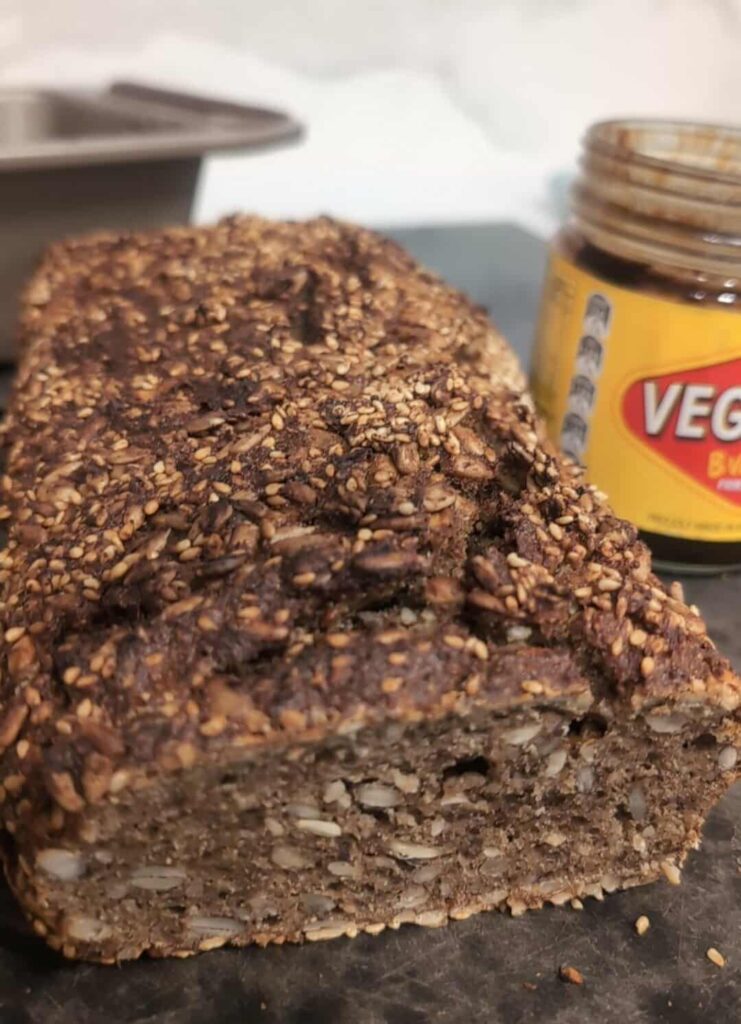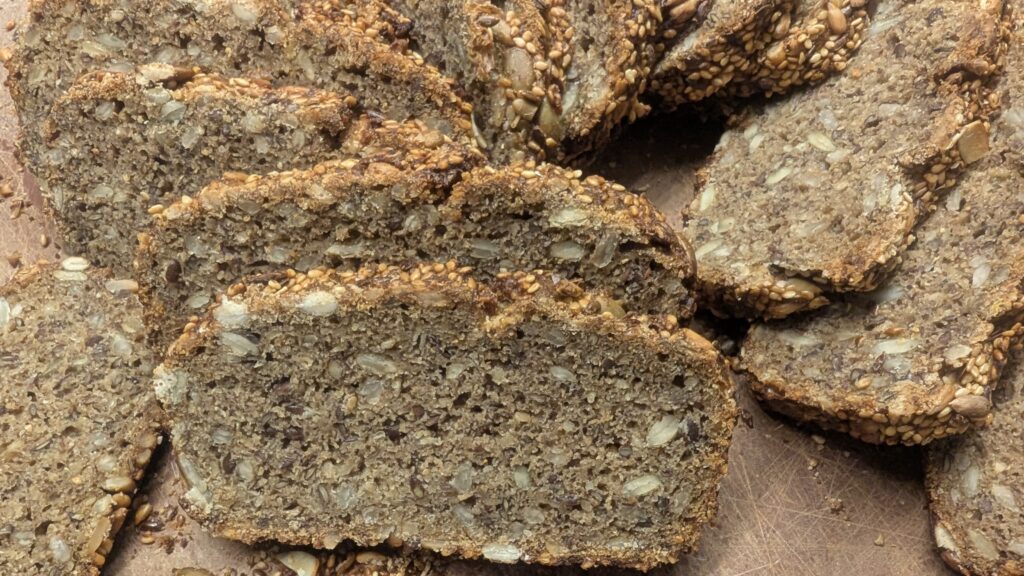This loaf inspired me to get back into baking sourdough. I wanted something that was minimum fuss, no stretching and folding or kneading. I was just interested in having something super healthy to have a slice of for breakfast when I didn’t feel like eating a breakfast biscuit, a keto waffle, a chia bowl or a protein shake. This loaf has increased my breakfast choices. I can even have it with mushrooms or an egg.
Of course the first step was making a sourdough starter. This was not such a hard thing. It was just a matter of feeding it. I found that a small feed and a long rise helped take the urgency out of worrying about it hitting its peak before I was ready. That will be addressed at the end.

SUPER SEEDED SOUGHDOUGH RYE BREAD
Makes 1 loaf
- Prep Time: 15 minutes + proofing
- Cook Time: 1 hour + cooling
Ingredients
- 190g 12-hour rye starter
- 10g salt
- 40g coffee liqueur – Tia Maria Dark Roast, or a shot of coffee or coffee and chicory
- 10g molasses or golden syrup
- 10g miso
- 180g warm water (40°C)
- 190g rye flour (or include 50g of whole wheat flour)
- 90g sunflower seeds, plus extra for coating
- 50g flaxseeds, plus extra for coating
- 50g ground flaxseeds or LSA
- 30g sesame seeds, plus extra for coating
- 30g pumpkin seeds, plus extra for coating
- Softened butter, for a good greasing of the loaf pan
Method
- Prepare the loaf pan: Grease the inside of a 13x20cm loaf pan with plenty of softened butter. This gives a crispy, buttery flavour to the seeds.
- Mix the wet dough: In a large bowl, combine sourdough starter, salt, miso, molasses/golden syrup, coffee liqueur and water and mix well to allow the flavours to get to know each other.
- Add the dry ingredients: Add remaining ingredients (seeds, flour etc) and mix gently using a dough stirrer or by hand until a thick, sticky, shaggy dough forms.
- Shape the dough: Use wet hands and a scraper to work the dough a little and shape it into a sausage shape, slightly thinner and shorter than the loaf tin.
- Coat with seeds: On a dinner plate, mix and spread out the extra seeds. Roll the loaf on the plate, coating the dough thoroughly, including the ends.
- Ferment and raise: Place the coated dough into the buttered pan. Cover with a piece of plastic wrap and a tea towel and let it ferment for 2-4 hours, on the bench, until it rises by about 30% and has an internal temperature of at least 23°C. Now put it in the fridge overnight until ready to cook. In Winter I have left it covered, on a table on the back verandah. It was about the same temperature overnight as the fridge. I wouldn’t do this is Summer.
- Cold oven, cold mix – ordinary oven: Put an extra loaf tin on the top (or some foil or a small baking tray) and put the cold loaf into the cold oven and set it to 230°C (hot air with steaming on my oven) and set a timer for 30 minutes. Put a pan on lower shelf of the oven and add a cup of water to it to provide some steam if not using a steam oven. At the 30 minute mark remove the cover from the pan, and insert a digital temperature probe into the dough, set to 95°C and bake until the temperature is reached, rotating the pan halfway through.
- Bake with steam*** using a Combi Steam oven, set it for professional baking classic at 200°C.
- The loaf reaches 95°C internally: Remove from the oven.
- Cool: Turn the loaf out onto a wire rack, and leave to set, preferably overnight. If this is not possible at least let it cool for several hours before slicing.
- Serve: I toast one slice of this and eat it for breakfast. To make this easy I slice the whole loaf into 5mm slices and store in a plastic airtight container in the freezer. I begin the process of making the next loaf when I get to about three quarters through the slices in the container.
Note
***Bake with steam without a steam oven: Put a cast iron or solid steel roasting or fry pan on the lower shelf.
Add 1 cup (250ml) of water to the roasting/fry pan to create a steam burst. Close the oven door and bake until the loaf reaches 95°C, rotating the pan halfway through cooking.

The Starter
I did it this way – no molly coddling in this house:
- 100g rye flour
- 100g kefir (or water)
- Put into a jar and stir well – it is quite a thick mix. Scrape down the sides and put an elastic band around the jar at the top of the level of the dough/kefir (water) mix.
- Cover the jar with plastic wrap and punch a few holes in it.
- Put in a warm spot and leave for 3 days. If it’s doubled in size then just use it. If it’s being slow add another 25g 0f rye flour and 25g of water or kefir, move the elastic band up and replace the plastic wrap. It should grow pretty rapidly to double.
- The recipe uses 180g of this starter.
The remainder can either be mixed with a heap of flour (about 3 times the weight of the leftover starter) and stirred well. It will just look like a crumbly flour. Label, cover and refrigerate. - OR….Weigh the remainder and add an equal quantity of rye flour and kefir. Stir well, label, cover and put in the fridge.
I split my remainder into 2 equal parts and put them both in the fridge. It’s a just in case one doesn’t work situation.
